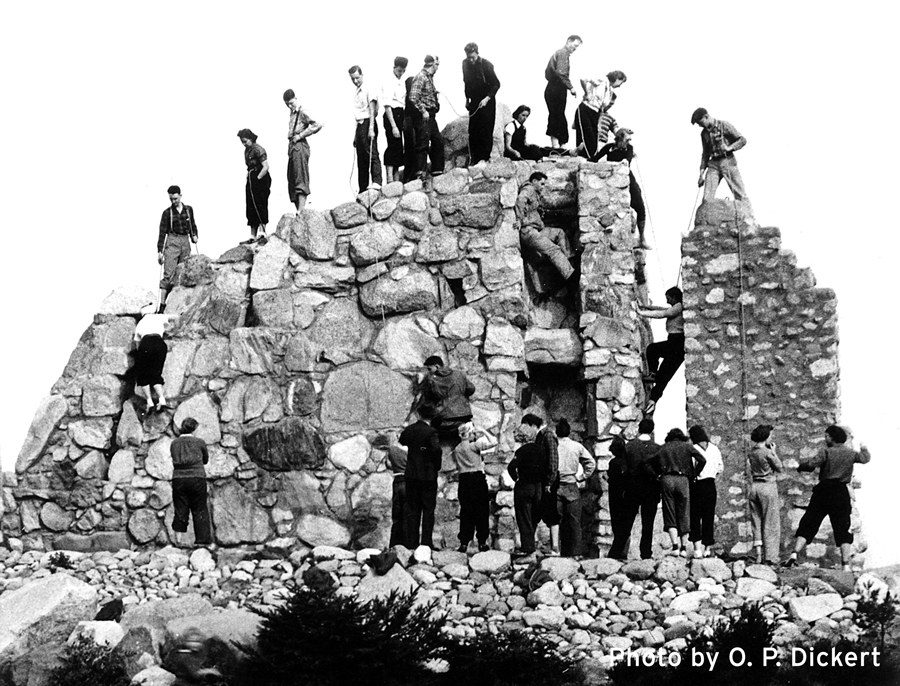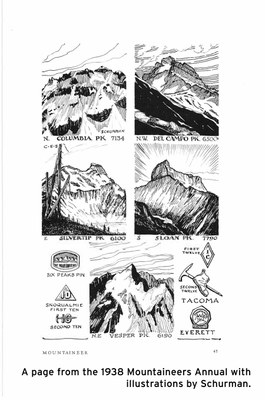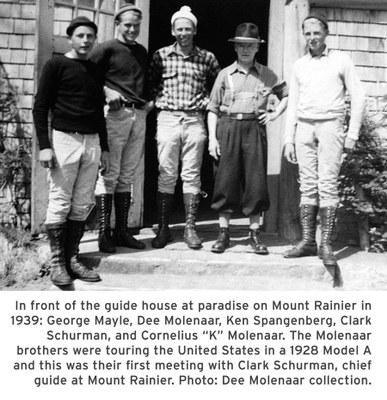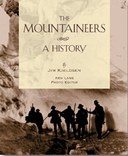
by Mary Hsue, former Mountaineers Director of Development and Communications
Clark Schurman joined The Mountaineers in 1936 and devoted his abundant energy and talent to developing mountaineering techniques and a philosophy oriented to safety. In his book, Molenaar called Schurman “An intense, brusk little man with the military way, he had a soul highly sensitive to the beauties of the mountain and to the dreams of youth. Visitors to the small, musty auditorium in the basement of the Guide House long remembered Schurman’s evening program of tinted lantern slides (and the first Kodachrome slides) which revealed the beauties of the mountain and its surrounding parklands. Schurman’s poetic interpretation of the great natural forces at work helped bring the mountain close to the hearts of his guests.”
Schurman also brought the mountains close to the hearts of Mountaineers members. From 1937 — 1939 he served on the editorial board of The Mountaineer Annual. It’s in these annuals where Schurman’s love of the mountains, talent and creativity, perhaps inspired by his immersion in nature while serving as a guide on Mt. Rainier, shone through.

Schurman contributed poetry and climbing illustrations in 1937, an illustration of the six majors — a significant club-wide award pin, 2 poems and a playful description of his first ascent of Monitor Rock at Camp Long in 1938, and in the 1939 Mountaineers annual, A Mountaineer’s Sketchbook, Schurman’s illustrations of 71 peaks representing club-wide and branch specific award pins complemented the images and descriptions of first ascents and club trips.
Before ending his run at the guide service at Mt. Rainier, Schurman helped plan and direct Camp Long, a city park in West Seattle designed for use by youth groups and mountaineering clubs. There he created a concrete “glacier,” complete with crevasses and steps fashioned into the steep “ice face,” for use in climbing instruction. It’s at Camp Long where Schurman designed and constructed Monitor Rock (after his death it was renamed Schurman Rock.) A twenty-foot-high “spire” made of native stone and concrete, the rock incorporates in its various sides the features that characterize a typical rock climb: ledges, overhangs, chockstones, friction pitches. Opened to the public in 1939, the rock has served as the in-town training ground for mountaineering classes. In the 1938 annual, Schurman proudly described the feature as having “its best corner oriented to make photographs on clear days, with Rainier in the background.”
While describing the features of the rock in the Mountaineer 1938 annual, Schurman suggested the feature “may not have enough interest to serve the Club’s own Climbers’ Classes,” but would certainly serve younger generations “if enough Mountaineers offer their services as instructors to organizations whose leaders want technical assistance.”

And they have. Over the years, thousands of Mountaineers students led by dedicated volunteer instructors have climbed and traversed Camp Long’s Schurman Rock. It’s a key part of the curriculum for both the scrambling course and basic climbing. Schurman’s award pin illustrations have also been passed down as a legacy. They’ve since been translated into badges which can be awarded online.
Several years after his death, in 1955 Clark Schurman’s long-expressed dream materialized in the construction of a shelter cabin at 9,500 Steamboat Prow. Named Camp Schurman in memory of “the chief,” the cabin was constructed by volunteer labor, with material purchased by donations from numerous former Boy Scouts, guides, Mountaineers and outdoor lovers who knew him over many years, and by money raised from a sale of oil paintings done by Schurman in his later years.
 Mary Hsue
Mary Hsue
